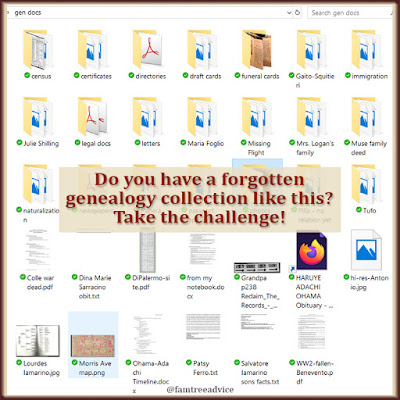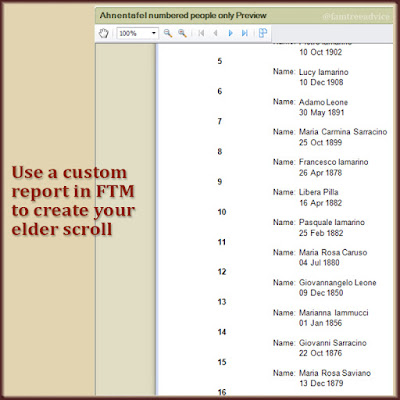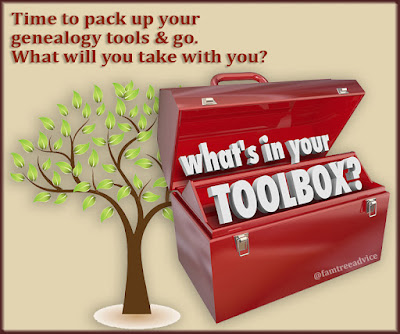I've got my super-charged database ready to help crack those connections.
It was my day off. And there isn't anything I'd rather do with my free time than work on my family tree. But where to begin?
After a quick look at GEDmatch, I decided I wanted to finally figure out why John is my DNA match. And my dad's match, too.
You see, my dad has 1st cousins I've visited in Italy. Their mother was my grandfather's sister Assunta. So Dad and I are blood relatives on their mother's side. But John is on their father's side. He is their father's brother. How am I related to their father's family?
I've built out my cousins' father's tree (and their Uncle John's) far and wide. His roots are in my grandfather's town where everyone is related somehow.
But all the people in John's family tree were related to me only through my Great Aunt Assunta's husband. How frustrating! Where was the hidden connection?
 |
| With extra determination, I finally found my connection to an unusual DNA match. |
Be Methodical
I began by viewing John's ancestors. Right away I saw a hole. I didn't have his maternal grandmother's birth date or ancestors. Another relative had a family tree showing her birth date as 6 Nov 1867, so I got straight to work.
My ace in the hole is my amazing database of Italian vital records. I've got all available records from my grandfather's hometown sitting on my computer. Plus, I renamed each image to include the name of the document's subject. Now I can search my computer for any name from the town.
Once I located John's grandmother Maria's birth record, I began working on her parents. Over and over I found death records for ancestors that gave me their parents' names. It was working so well that I identified all 8 of Maria's great grandparents. Only 1 of the 8 was a dead end.
Leave No Stone Unturned
As I found new ancestors, I used the Relationship Calculator in Family Tree Maker. Each new person was still related to me only through my Great Aunt's husband's family. No blood relation.
At this point I worried that my day off had been a bust. It was still fun, but I didn't get what I wanted. So, of course, I kept searching.
Again and again I went back to John and climbed each of his branches till I found a dead end. For each dead end, I searched for a death record that would tell me the names of the next generation.
Late in the day, I was looking at an ancestor named Vincenzo Mascia. I needed his parents' names, but he was too old for his marriage record to be available. (Records begin in 1809.) But Vincenzo's 1st wife died. He remarried within the range of my collection of marriage records.
In his marriage documents I found his birth record with his parents' names, Giorgio and Giulia. And there was his father Giorgio's 1812 death record. That had his parents' names, Domenico and Caterina.
Before typing Giorgio's parents' names into my tree, I did what I always do. Check to see if they're in my tree already. I held my breath because these parents were born in the late 1600s. I was way up there. And I did have a Domenico Mascia who was about the right age. Before I hovered over his name to see who he married, my heart skipped a beat. He had a yellow circle next to his name in the person index. That means he is my direct ancestor. Yellow means he's a direct ancestor of my father's father.
When I hovered over Domenico's name I gasped. His wife was the Caterina Paolucci I was hoping for. Domenico and Caterina are my 7th great grandparents, and I had climbed John's family tree to find them. They are his 5th great grandparents.
Consult the Charts
So I whipped out my relationship chart. I'd found something similar online once, but decided to make my own, which is much easier to use. Since Domenico and Caterina are my 7th great grandparents and John's 5th great grandparents, he and I are 6th cousins twice removed. John and my dad are 6th cousins once removed.
 |
| Download your own: https://www.dropbox.com/s/ksvp08b99pzk9hl/relationship-calculator.xlsx?dl=0 |
Ancestry DNA estimated that John and I (and John and my dad) were 4th–6th cousins. Well, there you go!
This finding was a long time coming. I've been collaborating with John's daughter-in-law since 2017 trying to figure this out. Ironically, while John is my 6th cousin twice removed, his wife is my 5th cousin twice removed. I was working on her ancestors this past Sunday.
I've got a ton of work yet to do on this branch. I was so excited with my progress that I entered all the facts, but I have to go back and add the documents and source citations to my tree.
I hope I've inspired you to keep at it when you can't find the connection to your DNA match. Use all your resources and keep pushing forward. You never know which path will help you solve the puzzle.









